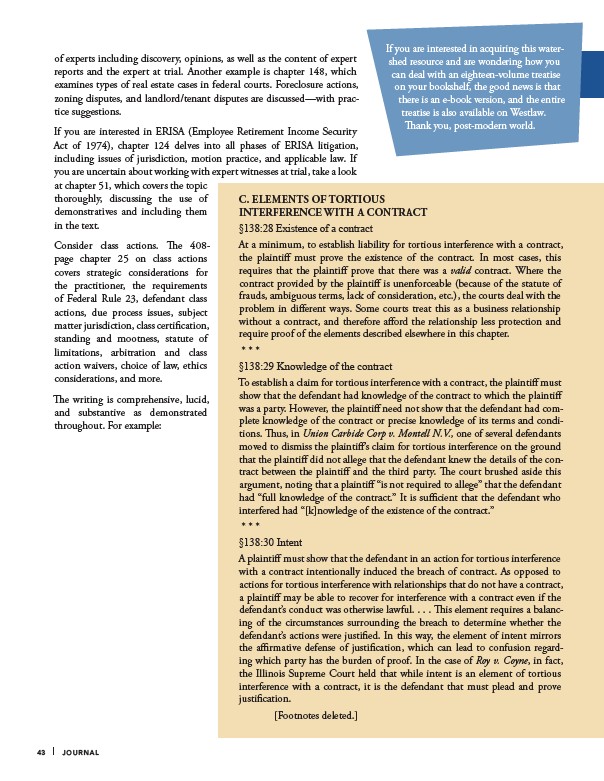
of experts including discovery, opinions, as well as the content of expert
reports and the expert at trial. Another example is chapter 148, which
examines types of real estate cases in federal courts. Foreclosure actions,
zoning disputes, and landlord/tenant disputes are discussed—with practice
suggestions.
If you are interested in ERISA (Employee Retirement Income Security
Act of 1974), chapter 124 delves into all phases of ERISA litigation,
including issues of jurisdiction, motion practice, and applicable law. If
you are uncertain about working with expert witnesses at trial, take a look
at chapter 51, which covers the topic
thoroughly, discussing the use of
demonstratives and including them
in the text.
Consider class actions. The 408-
page chapter 25 on class actions
covers strategic considerations for
the practitioner, the requirements
of Federal Rule 23, defendant class
actions, due process issues, subject
matter jurisdiction, class certification,
standing and mootness, statute of
limitations, arbitration and class
action waivers, choice of law, ethics
considerations, and more.
The writing is comprehensive, lucid,
and substantive as demonstrated
throughout. For example:
C. ELEMENTS OF TORTIOUS
INTERFERENCE WITH A CONTRACT
§138:28 Existence of a contract
At a minimum, to establish liability for tortious interference with a contract,
the plaintiff must prove the existence of the contract. In most cases, this
requires that the plaintiff prove that there was a valid contract. Where the
contract provided by the plaintiff is unenforceable (because of the statute of
frauds, ambiguous terms, lack of consideration, etc.), the courts deal with the
problem in different ways. Some courts treat this as a business relationship
without a contract, and therefore afford the relationship less protection and
require proof of the elements described elsewhere in this chapter.
* * *
§138:29 Knowledge of the contract
To establish a claim for tortious interference with a contract, the plaintiff must
show that the defendant had knowledge of the contract to which the plaintiff
was a party. However, the plaintiff need not show that the defendant had complete
knowledge of the contract or precise knowledge of its terms and conditions.
Thus, in Union Carbide Corp v. Montell N.V., one of several defendants
moved to dismiss the plaintiff’s claim for tortious interference on the ground
that the plaintiff did not allege that the defendant knew the details of the contract
between the plaintiff and the third party. The court brushed aside this
argument, noting that a plaintiff “is not required to allege” that the defendant
had “full knowledge of the contract.” It is sufficient that the defendant who
interfered had “knowledge of the existence of the contract.”
* * *
§138:30 Intent
A plaintiff must show that the defendant in an action for tortious interference
with a contract intentionally induced the breach of contract. As opposed to
actions for tortious interference with relationships that do not have a contract,
a plaintiff may be able to recover for interference with a contract even if the
defendant’s conduct was otherwise lawful. . . . This element requires a balancing
of the circumstances surrounding the breach to determine whether the
defendant’s actions were justified. In this way, the element of intent mirrors
the affirmative defense of justification, which can lead to confusion regarding
which party has the burden of proof. In the case of Roy v. Coyne, in fact,
the Illinois Supreme Court held that while intent is an element of tortious
interference with a contract, it is the defendant that must plead and prove
justification.
Footnotes deleted.
If you are interested in acquiring this watershed
resource and are wondering how you
can deal with an eighteen-volume treatise
on your bookshelf, the good news is that
there is an e-book version, and the entire
treatise is also available on Westlaw.
Thank you, post-modern world.
43 JOURNAL